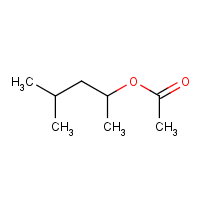sec-Hexyl acetate
Agent Name
sec-Hexyl acetate
CAS Number
108-84-9
Formula
C8-H16-O2
Major Category
Solvents

Synonyms
1,3-Dimethylbutyl acetate; 1,3-Dimethylbutyl ethanoate; 1,3-Dimethylbutylester kyseliny octove [Czech]; 2-Pentanol, 4-methyl-, acetate; 4-Methyl-2-amyl acetate; 4-Methyl-2-pentanol, acetate; 4-Methyl-2-pentyl acetate; Acetic acid, 1,3-dimethylbutyl ester; Methyl amyl acetate; Methylamyl acetate; Methylisoamyl acetate; Methylisobutylcarbinol acetate; Methylisobutylcarbinyl acetate; sek.Isohexylester kyseliny octove [Czech]; [ChemIDplus] UN1233
Category
Esters (<C12)
Description
Colorless liquid with a mild, pleasant, fruity odor; [NIOSH]
Sources/Uses
Used as a lacquer solvent and fragrance; [ACGIH]
Comments
Esters may induce narcosis in animals, but workers' exposures are limited by irritating effects. See appendix in: [Dick RB, et al. Chemicals in the workplace: incorporating human neurobehavioral testing into the regulatory process. Am J Ind Med. 1998 May;33(5):439-53.] A skin, eye, and respiratory tract irritant; Inhalation of high concentrations can cause CNS depression; [ICSC] TLV Basis is CNS impairment and irritation of eyes and upper respiratory tract. [ACGIH]
Biomedical References
Exposure Assessment
Skin Designation (ACGIH)
Insufficient data
TLV (ACGIH)
20 ppm
PEL (OSHA)
50 ppm
IDLH (NIOSH)
500 ppm
Excerpts from Documentation for IDLHs
Volunteers noted an unpleasant odor and irritation of the eyes and upper respiratory tract at 100 ppm [Silverman et al. 1946].
Vapor Pressure
4 mm Hg
Odor Threshold Low
0.39 ppm
Lethal Concentration
LCLo (rat) = 2,000 ppm/4H
Explanatory Notes
Odor threshold from AIHA; Flash point = 45 deg C; VP from HSDB;
NFPA
high ambient temp required
Adverse Effects
Neurotoxin
Acute solvent syndrome
Diseases, Processes, and Activities Linked to This Agent
Diseases
Occupational diseases associated with exposure to this agent:
Processes
Industrial Processes with risk of exposure: